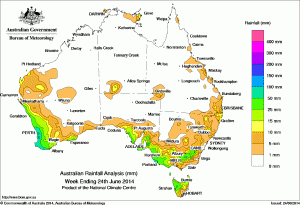
Rain recorded across Australia for the seven days to June 24, 2014. Click on map to view in larger format.
Most of Australia missed out on rainfall for the previous week, with the most significant falls occurring in southwest Western Australia, coastal South Australia, Victoria, Tasmania and the eastern half of New South Wales.
A strong frontal system approached Western Australian at the beginning of the week, generating some moderate falls in the southwest of the state. A moist, westerly flow persisted over southern parts of Western Australia as the system moved into the Southern Ocean while onshore flow produced some light showers along parts of the Queensland coast at mid-week.
Near the end of the week, a strong cold front moving over the southern Indian Ocean generated a significant middle level cloudband, stretching from northwest Western Australia to south of the Great Australian Bight. The cold front and deep low pressure system swept through South Australia, Victoria and inland New South Wales before moving off the east coast.
The highest weekly rainfall total of 136 mm was recorded at Pickering Brook in the Central Coast district in Western Australia. Falls in excess of 100 mm were recorded in other isolated areas of southwest Western Australia.
Rainfall totals between 50 mm and 100 mm were recorded along the coast of southwest Western Australia, and in small areas of west coast Tasmania, southeastern South Australia, the far southwest of Victoria as well as isolated falls in the Victorian Alpine region.
Rainfall totals between 15 mm and 50 mm were recorded in northern and western Tasmania, the southern agricultural districts of South Australia, western Victoria, through parts of central Victoria to the Alpine and Snowy Mountains regions and in a broad strip along the coast of Western Australia south of Carnarvon.
Isolated falls in excess of 15 mm were recorded on the southeast Queensland coast. Some isolated falls of more than 10 mm were also recorded along the west coast, in central and far northern Australia, and scattered along the east coast in New South Wales and Queensland.
Most of the Northern Territory, Queensland, inland New South Wales, northern South Australia, and Western Australia away from the southwest recorded little or no rainfall.
Heaviest falls by State:
| State | Highest | 2nd Highest | 3rd Highest |
|---|---|---|---|
| WA | Pickering Brook (136 mm) (Central Coast) |
Bickley (131 mm) (Central Coast) |
Bungendore (126 mm) (Central Coast) |
| NT | Alcan Minesite (22 mm) (Arnhem) |
Yirrkala Tropical Gardens (21 mm) (Arnhem) |
Gove Airport (20 mm) (Arnhem) |
| SA | Piccadilly (Woodhouse) (101 mm) (East Central) |
Lobethal (97 mm) (East Central) |
Belair (97 mm) (East Central) |
| Qld | Regents Park (30 mm) (Moreton) |
Point Lookout (29 mm) (Moreton) |
Sandy Cape Lighthouse (28 mm) (Port Curtis) |
| NSW/ACT | Perisher Valley (54 mm) (Snowy Mountains) |
Tumbarumba Post Office (40 mm) (Southwest Slopes) |
Thredbo Village (34 mm) (Snowy Mountains) |
| Vic | Falls Creek (Rocky Valley) (92 mm) (Upper Northeast) |
Grampians (Mount William) (65 mm) (South Wimmera) |
Myrhee (Handcocks) (60 mm) (Lower Northeast) |
| Tas | Lake Margaret (48 mm) (West Coast) |
Rosebery (44 mm) (West Coast) |
Naracoopa (43 mm) (King Island) |
Source: Bureau of Meteorology
